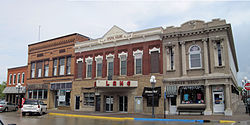Clear Lake, Iowa
| Clear Lake, Iowa | |
|---|---|
| City | |

Historic Downtown Clear Lake
|
|
 Location of Clear Lake, Iowa |
|
| Coordinates: 43°8′11″N 93°22′48″W / 43.13639°N 93.38000°WCoordinates: 43°8′11″N 93°22′48″W / 43.13639°N 93.38000°W | |
| Country | US |
| State |
|
| County | Cerro Gordo |
| Area | |
| • Total | 13.44 sq mi (34.81 km2) |
| • Land | 10.80 sq mi (27.97 km2) |
| • Water | 2.64 sq mi (6.84 km2) |
| Elevation | 1,237 ft (377 m) |
| Population (2010) | |
| • Total | 7,777 |
| • Estimate (2012) | 7,741 |
| • Density | 720.1/sq mi (278.0/km2) |
| Time zone | Central (CST) (UTC-6) |
| • Summer (DST) | CDT (UTC-5) |
| ZIP code | 50428 |
| Area code(s) | 641 |
| FIPS code | 19-14025 |
| GNIS feature ID | 0455465 |
| Website | clearlakeiowa |
Clear Lake is a city in Cerro Gordo County, Iowa, United States. The population was 7,777 at the 2010 census. The city is named for the large lake on which it is located. It is the home of a number of marinas, state parks and tourism-related businesses. Clear Lake is also a major stop on Interstate 35 with many restaurants, hotels and truck stops.
The region around the lake that would later be called Clear Lake was a summer home to the Dakota and Winnebago American Indians. During a land survey of northern Iowa done in 1832 by Nathan Boone, the son of the famous explorer, Daniel Boone, a map was made showing the lake and other bodies of water in the area.
In 1851, Joseph Hewitt and James Dickirson brought their families to camp on the east side of Clear Lake, soon building a cabin, and began a friendship with the Winnebago natives. By 1853, many more white settlers had also came to settle in the area. By the year 1855, the first Clear Lake school was built and the first steam saw mill. In 1855, a hotel was built by James Crow.
By 1870, the town had 775 residents and by 1871 the streets were graded and sidewalks were made of raised boards, a sure sign of thriving new city. The city of Clear Lake was incorporated on May 26, 1871. The first bandstand built in Clear Lake was in 1877 at the City Park. The town grew and built its first library in 1889. In 1909, Bayside Amusement park opened for the first time. The first North Iowa Band Festival was organized by John Kopecky and others in 1932
In 1933, the Surf Ballroom open up on the site of the old Tom Tom ballroom that had been destroyed by fire. The opening dance night had approximately 700 couples attending. In 1947, the Surf Ballroom burned down and a new Surf Ballroom was built across the street in 1948. The Bayside Amusement park closed down in 1958.
In the early hours of February 3, 1959, a Beechcraft Bonanza aircraft carrying Buddy Holly, Ritchie Valens, and The Big Bopper, who had been performing at the Surf Ballroom in Clear Lake, took off from the local runway in nearby Mason City, on its way to the next show in Moorhead, Minnesota.
...
Wikipedia
